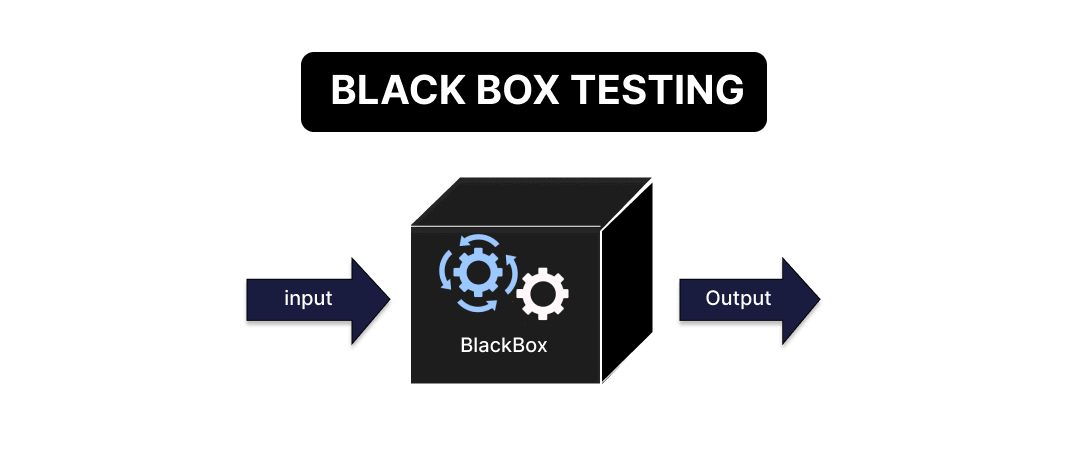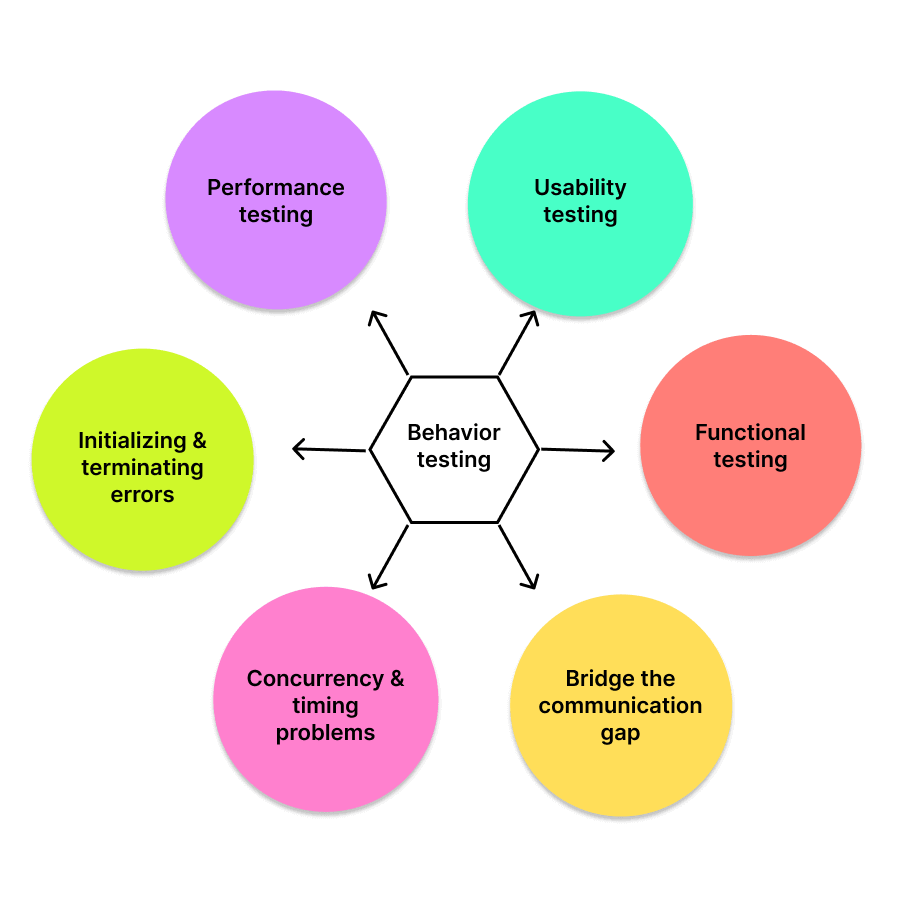What is Black Box Testing: Techniques, and Best Practices
- Learning Hub
- What is Black Box Testing: Techniques, and Best Practices
OVERVIEW
Black box testing is a software testing methodology that focuses on the functional requirements of a system without considering its internal workings or implementation details. The tester need not have any knowledge of the internal structure or design of the system.
It ensures that a system meets the requirements specified by the customer or user. A black box test can be conducted at different levels, including unit testing, integration testing, and system testing. In order to identify defects and ensure that a system works properly, running black box tests is a valuable approach.
What is Black box testing?
Black box testing is a software testing method that examines the software without prior knowledge of its internal structure. It can be contrasted with White box testing, which involves a more in-depth knowledge of the software's implementation details.
In theory, Black box tests can be run by anyone, independent of the development team, and a developer's familiarity with the code should not affect how well their code is tested; conversely, White box tests tend to require a developer's intimate understanding of the code to construct test cases.

So the primary job of a software tester while running Black box tests is to test the functionalities of software applications when the internal paths & code structure are not known.
The customer's set of detailed requirements for the product is tested. These requirements are related to different functions, so a tester chooses a function, enters an input value, and examines the output. If the function's result is correct, it is passed in testing.
It is also sometimes referred to as behavioral testing, as instead of the technical perspective, behaviors are considered from the point of view of a software program in various situations.
Why should we perform Black box or behavior testing?
The need is to determine how a software program behaves instead of focusing on the technical aspects under various conditions. It also helps you to identify different errors like:
- Performance errors.
- Usability errors.
- Functionality errors.
- Initializing & terminating errors.
- Concurrency & timing problems.
- Bridge the communication gap.

Advantages of Black box testing
In this section, we will discuss some of the benefits of executing Black box tests.
- The way users interact with a product and their overall perception, i.e., tests are performed from the user’s point of view. Things like meeting customers’ expectations & discrepancies in the specifications are tested.
- Developers and testers work independently to avoid bias.
- Big and complex software systems can be tested more effectively using this method. It is especially useful for the testing of large systems.
- Testers do not need technical knowledge or programming skills. They do not need to know IT jargon or how the software has been built.
- Little chance of false positives.
- If a defect is detected early in the testing process, you can correct it easily.
Limitations of Black box testing
By definition, Black box tests are done without seeing the inner workings of the application. That said, there are still limitations to what you can accomplish with this method.
- Only a limited number of inputs can be tested, and many program paths will not be checked.
- In many projects, there are no clear specifications. This can make test case design challenging.
- If you don't have technical or programming experience, the risk is that you might not consider all the possible circumstances in your scenario.
- Complete test coverage is impossible.
- It is possible to accelerate the testing process by skipping testing inputs and outputs that are not currently being used.
- If a software designer/developer has already run a test case, additional tests may not be necessary.
Scope of Black box testing
Black box tests ensures to keep a check on the input that enters the software while checking the desired output. Below is the scope of Black box tests.
- Test your software easily so that desired use is fulfilled.
- Testers can perform this operation without any coding knowledge of the application.
- It helps examine the functionality of the software.
Types of Black box testing
Black box testing is used in three main types of software testing: functional, non-functional, and regression.
- Functional Testing
- Non-functional Testing
- Regression Testing
We test the functionality of a software program by specific functions or features of the software. The functional requirements of a system are tested, for example, logging in to an eCommerce site through the correct credentials & also checking through the wrong credentials whether the desired output is obtained.
In non-functional testing, there is a focus on “HOW’. It doesn’t test if the features & functions are performed well but focuses on the how part of testing. Non-functional testing is never carried out before functional testing.
After a fix, upgrade, or other system maintenance, regression testing is done to ensure the new code hasn't adversely affected existing code. It is used to determine whether a new version of the software performs as well as or better than the previous version. It's possible that a fixed defect could have introduced another defect.
Different Black box testing techniques
Many different Black box test techniques help in testing various features of the software. There are several techniques available out there, but not all of them can be used for every type of application. Some basic techniques are:
- Equivalence Partitioning
- Boundary Value Analysis
- Decision Tables
- State Transition Testing
- Error Guessing
- Use Case Testing
- Cause-Effect Technique
- All Pair testing Technique
In this, we need to break up possible inputs into groups and test one example input from each group. An equivalence class is a set of data items considered equivalent to each other, so it will receive the same processing when sent as input to an application.
For example, a food company's software might charge different subscription fees for people who are already members for 2 years & different for new members. In this case, it is sufficient for testers to check only one case from each group.
This technique is closely associated with equivalence class partitioning. A system exhibits a special response at a specific value of an input; that specific response at that specific value is called its boundary. We analyze the application's behavior with test data at the boundaries of equivalence classes.
For example, a specific field may accept only values within that range, like supposing a range is 0 to 100. The tester will see if the system accepts and rejects inputs correctly when the number above is entered.
Testing the application’s behavior based on different combinations of input values is called decision tables testing. Many systems provide outputs depending on the conditions in which they are operating. The columns each have a unique combination of elements. Testers can identify the conditions that must be satisfied for a rule to apply, determine the outcome of each rule, and design a test case for each rule. The functions that have a logical relationship between two or more inputs are appropriate.
It is a way to determine what the software application does when different values of input are given to the same function. Generally used in cases where there is a transition from one state to another. Like in the case of the login mechanism where after a specific number of failed login attempts, it goes into a transition where the locking of the account takes place.The testers here design test cases that probe the system when it transitions states.
This technique involves identifying common errors developers make when building similar systems. It’s a way to identify errors without setting forth a specific method. The tester will be guided by experience when trying to find unknown problems in software here.
Use case testing is a form of software testing that uses use cases. As per the usage of the system, they are used to identify the test cases from start to end. A test scenario is created based on the functionality of each function from beginning to end.
It's a technique that explains the relationship between a result and all the factors that impact it. Dynamic test cases are used here. This technique, also called the cause-effect graph technique, is based on a collection of requirements and is used to determine the minimum number of tests that can cover the maximum number of sections in the software.
The cause-and-effect graph technique can convert the requirements specification into a logical relationship between input and output conditions.
It is also known as pairwise testing. It is used to test all the possible combinations of values. The applications that use checkbox input, radio button input, list box, and text box use this combinatorial method.
Tools to perform Black box testing
With so many options to choose from, it can be hard to find the right tools you need to test applications. Here are some of the most common tools
- Selenium - Selenium is a browser automation tool that lets you write scripts in the programming language of your choice. Selenium provides a variety of drivers to support almost all web browsers., and it lets you perform different actions in each browser.
- Appium - Appium is a community-driven open source project that's developing an open standard for automated testing of mobile websites and apps. It is a cross-platform testing framework, supporting both Android and iOS native apps and websites accessed through mobile browsers.
- LoadRunner - LoadRunner, from Micro Focus, is a testing tool that measures how applications behave under heavy loads. LoadRunner helps you test mobile apps by measuring their performance, scalability, and capacity.
- JMeter - JMeter is a Java-based load and performance testing tool that works with JDK 5 or higher. It's used to test the performance of Web applications and other types of software under heavy loads.
How to perform Black box testing?
In this section, let's look at how to run your Black box tests.
- Determine and understand the software application's requirements and specifications.
- Check valid and invalid inputs along with expected outputs to validate that the system identifies them appropriately.
- Create automated test cases with multiple test scenarios and inputs.
- Run the test cases.
- Validate the desired results with the actual results.
- Resolve test case errors.
- After, re-test the application to avoid recurring bugs.
While performing testing, you must also take different browsers, browser versions, devices and operating system into account. It ensure your software applications works perfectly across each configuration.
Instead of procuring every browsers, devices and OS for your target audience, consider using a cloud-based testing infrastructure like LambdaTest.
LambdaTest's real device cloud offers 3000+ real browsers, devices and OS for manual and automation testing. Therefore, you can check how your website or app renders and works on different browsers, devices, and OSes. With LambdaTest test automation cloud, you get faster test execution speeds and faster developer feedback. This in turn cuts down overall costs related with finding issues at later stages of software development.
With LambdaTest Automation testing platform, you can automate web testing with various automated testing tools like Selenium, Cypress, Playwright, Puppeteer, TestCafe, Appium, Espresso, etc.
Subscribe to the LambdaTest YouTube Channel and stay updated with the latest tutorials around Selenium testing, End-to-End (E2E) testing, CI/CD, and more
White box vs. Black box testing: Differences
Let's look at the differences between Black box and White box testing.
| White box testing | Black box testing |
|---|---|
| Developers usually work on it. | Testers usually perform this task. |
| The tester is familiar with the ins and outs of the internal structure and code. | In this type of software testing, the internal structure or code behind the program is hidden. |
| You need to write some code to make it work. | You don't need to write some code to make it work. |
| It is the process of testing an application's structure. | It is the functional testing of an application. |
| Software testing begins after the design document has been finalized. | The testing process can start by checking the required specification documentation. |
| It can take a long time. | Doesn't take much time. |
| It is perfect for testing algorithms. | It is not the best way to test an algorithm. |
| This method is most effective for lower levels of software testing. | This method is most effective for higher levels of software testing. |
Conclusion
In this guide, we have covered some of the main points regarding Black box testing, its advantages & disadvantages so you can decide in what situations you should do it.
Happy Testing!!!
Frequently Asked Questions (FAQs)
Why is it called Black box testing?
Black box testing is a method of software testing in which the tester has no prior knowledge of the system being tested.
What are the characteristics of Black box tests?
It tests the application's functionality and its non-functional requirements. Testers don't need access to the software's coding/design/internal architecture. This allows them to work independently from developers
What are Black box testing types?
There are three main types of Black-box testing: functional testing. non-functional testing. regression testing.
What is black box testing?
Black box testing is a software testing technique where the internal workings of a system are not known to the tester. It focuses on validating the functionality and behavior of the system without considering its internal structure. The goal is to assess the system solely based on its inputs and outputs.
What is black box penetration testing?
Black box penetration testing is a cybersecurity assessment where ethical hackers evaluate a system without prior knowledge of its internal workings. They simulate real-world attacks to identify vulnerabilities and assess the system's security posture. The goal is to provide actionable insights for improving defenses against potential threats.
What is black box testing and white box testing?
Black box testing is a software testing technique where the internal workings of the system are not known to the tester. It focuses on the system's inputs, outputs, and functionality. In contrast, white box testing involves examining the internal structure and implementation of the system to ensure code correctness.
Why might companies prefer black box testing over white box testing?
Companies may prefer black box testing over white box testing due to several reasons. Black box testing focuses on the software's functionality from a user's perspective, ensuring a better assessment of real-world scenarios. It requires no knowledge of internal code, making it easier to perform and allowing non-technical personnel to participate.
What is black box testing method?
Black box testing is a software testing method where the internal workings of a system are not considered. It focuses on validating the functionality and behavior of the system from an external perspective. This method verifies inputs and expected outputs without inspecting the internal code or structure.
What are the advantages of black box testing?
Black box testing offers several advantages. It allows for independent test design, focusing on functionality rather than internal structure. It simulates end-user experience, identifying real-world issues. Additionally, it facilitates effective bug detection, enhances software quality, and reduces development time by parallelizing testing and coding.
What are the 3 key features of black box testing?
The three key features of black box testing are: 1) Testing without knowledge of the internal structure or code of the system, 2) Focus on the system's external behavior and inputs/outputs, 3) Objective is to uncover errors, functionality issues, and ensure expected functionality.
Author's Profile

Rajas Nawar
Rajas Nawar, with three years of experience, is a dynamic and proficient writer and marketer in the software testing arena. He is renowned for his extensive knowledge of diverse testing methodologies, tools, and frameworks. Rajas has a talent for simplifying intricate testing concepts, making them easily understandable for everyone from novices to experts in the field. More than just a writer, he is a perpetual learner, constantly enhancing his expertise and abilities in the ever-evolving world of software testing.
Reviewer's Profile

Shahzeb Hoda
Shahzeb currently holds the position of Senior Product Marketing Manager at LambdaTest and brings a wealth of experience spanning over a decade in Quality Engineering, Security, and E-Learning domains. Over the course of his 3-year tenure at LambdaTest, he actively contributes to the review process of blogs, learning hubs, and product updates. With a Master's degree (M.Tech) in Computer Science and a seasoned expert in the technology domain, he possesses extensive knowledge spanning diverse areas of web development and software testing, including automation testing, DevOps, continuous testing, and beyond.
Try LambdaTest Now !!
Get 100 minutes of automation test minutes FREE!!

 Christmas Deal is on: Save 25% off on select annual plans for 1st year.
Christmas Deal is on: Save 25% off on select annual plans for 1st year.

